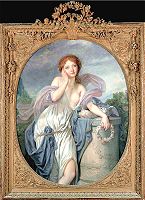 click to enlarge |
MEDITATIONJean Baptiste Greuze SN 382, oil on canvas, C. 1780 From: "The Pages"
|
ARTIST:
Born in Tournus, France, in 1725; he was a prolific,artist, introducing the sentimental, moralizing genre to French painting. He is well represented in the Louvre and a museum in Tournus is dedicated to him, but he died in poverty in 1805.
After a time of studying antique sculpture in Rome, he returned to France, successfully exhibiting his many paintings of contemporary bourgeoisIe. Wanting to be remembered as a history painter, his acceptance in the Academy as a genre painter disappointed him. Rejecting the Salon exhibition, he used his Louvre studio to receive royal visitors from Sweden & Russia. His work was highly popular until later in his career when he began turning out a series of titillating pictures of young girls, mawkishly innocent on the surface, but containing thinly veiled sexual allusions. His frequent model was his young wife, and the popularity of his paintings may have been due in part to her beauty.
SUBJECT:
Meditation is an allegory of lost innocence; a study of erotic tensions which contrasts contradictory images, to be read like a novel. The young girl is alone, deep in private thought, unaware of the viewer’s gaze. Her almond-shaped eyes are heavy lidded, her expression one of dreamy desire. Her mouth is full, nose acquiline, her hair center-parted in the style of an antique Greek sculpture. The column and the wreath also bear out the classic reference.
Her disheveled drapery swirls around bare shoulders and exposes an adolescent breast. (She can be compared to Venus, often portrayed in a white gown with sea-blue stole.) There is a contradiction to the mood, however: her virginity is protected by the rope firmly tied about her lower body.
PAINTING:
Leaning on her plinth, she suggests a Vestal Virgin – pure, chaste, guarding the sacred hearth as civic duty, while a boneless, impotent hand executes a "thinking” gesture. But her arm separates the two doves (Venus’ attribute), who display poses of the nesting female and aggressor male. And instead of the victorious laurel wreath of Olympians, she holds a wreath of flowers.
Greuze, like Poussin, elevates life through the clarity and beauty of a formal presentation, meant to be easily read. The museum of the Rhode Island School of Design has a nude study by Greuze, which seems an x-ray version of this elongated, Mannerist body with its sensuously curved hip.
HISTORIC CONTEXT:
Greuze’s pictorial sermon illustrates the social gospel of Jean-Jacques Rousseau, that the poor are imbued with “natural virtue” and honest sentiment, unlike the immoral aristocracy. Gestures and expression are exploited to the smallest detail.
Denis Diderot, the apostle of reason and nature, praised Greuze for his social mission, which appealed to the beholder’s moral sense, instead of merely giving pleasure like most of the frivolous Rococo artists. Greuze really was interested in proper behavior for young women. His was a pictorial counterpart to Diderot’s melodramas of “noble and serious human action” in Poussin’s sense.